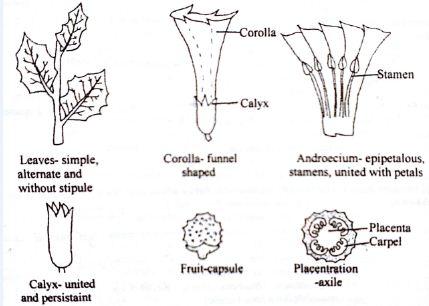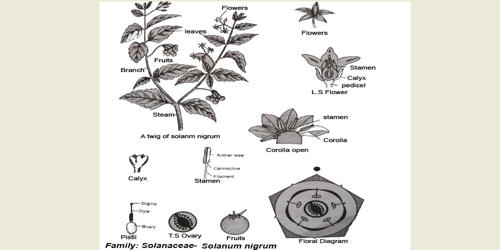The Solanaceae include a number of commonly collected or cultivated species. Solanaceae, or nightshades, are an economically important family of flowering plants with a worldwide distribution. The Solanaceae family of vegetables include potatoes, tomatoes, eggplant, capsicum, and chilies.
Here point out identifying characteristics of the family Solanaceae:
(i) Plant: Usually shrub or herb
(ii) Leaf: Simple and stipule-less. Petiolate; alternate or opposite; simple; exstipulate;
(iii) Calyx: 5 sepals united and persistent. Fused (gamosepalous); green; often much enlarged in the fruit.
(iv) Corolla: 5 petals; gamopetalous; bell-shaped or funnel-shaped. Usually whorled or funnel-shaped.
(v) Androecium: Stamens epipetalous and arranged alternately with petals.
(vi) Placentation: Axile, arranged obliquely with mother-axis.
(vii) Stamens: 5 stamens; epipetalous; anther free or united; basifixed
(viii) Flower: Pedicillate; ebracteate; actinomorphic or zygomorphic; Regular; complete; hermaphrodite; hypogynous;
(ix) Fruit: Usually berry, rarely capsule.
(x) Habit: Annual, biennial or perennial herbs, or small tree.
Example: Solanum melongena.

General Information
- Common name: Potato family or Nightshade family
- Number of genera: This family includes 90 genera and about 3000 species
- Propagation type: Fruit (dehisced or intact) or seed
- Distribution: Solanaceae is a large family consisting of 90 genera distributed in tropical and temperate regions of the world. They are mainly found in Central and South America.
Vegetative characters
- Habitat: Members of this family are mostly mesophytes and some are xerophytes.
- Habit: The habit of the members of this family is variable. Some plants are annuals or perennial herbs. Few plants are shrubs and small trees and rarely climbers.
- Root system: The members of this family have a tap root system.
- Stem: The stem is aerial, erect, and mostly herbaceous. It is covered either by prickles or spines, spines are modified branches.
- Leaf: Leaves are simple, entire, lobed, exstipulate, and petiolate. Leaves show alternate or terminal phyllotaxy in the vegetative regions.
Floral characters
- Inflorescence: It is usually a cymose type. It may be terminal or axillary in position.
- Flower: The flowers appear to be solitary and axillary as in Datura. Flowers are sometimes clustered as in Withania.
- Calyx: The calyx consists of 5 sepals that are fused. The aestivation is valvate. The calyx in some plants (Solanum) is persistent and much enlarged in fruit.
- Corolla: The corolla consists of 5 petals. Corolla is gamopetalous and funnel-shaped, campanulate, rotate.
- Androecium: Stamens are five in number, epipetalous on the corolla tube, and alternate with the lobes. They are usually unequal in height.
- Pollination: Flowers are usually protandrous. Some species of Solanum are protogynous. Cross-pollination through insects is common.
- Fruit: The fruit is mostly berry sometimes enclosed within an inflated bladder-like calyx or it is a capsule which dehisces by valves (Datura) or circumcised above the middle.
- Seed: The seeds are numerous, compresses, discoid or suberniform, dicotyledonous, endospermic with curved or straight (Nicotiana) embryo.












